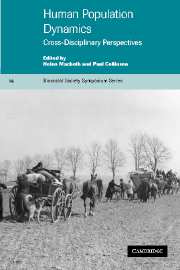Book contents
- Frontmatter
- Contents
- List of contributors
- Foreword by G.A. Harrison
- Preface
- 1 Introduction: the framework of studying human population dynamics
- 2 Demographic perspectives on human population dynamics
- 3 The growing concentration of world population from 1950 to 2050
- 4 Population, community and society in peasant societies
- 5 From genetic variation to population dynamics: insights into the biological understanding of humans
- 6 Social institutions and demographic regimes in non-industrial societies: a comparative approach
- 7 The dynamics of child survival
- 8 Genetic structure of south Indian caste populations: a confluence of biology and culture
- 9 Fertility, mortality and migration transitions in association with socioeconomic modernisation among highland minority populations in Southeast Asia
- 10 Ecology, homeostasis and survival in human population dynamics
- Glossary
- Index
- References
10 - Ecology, homeostasis and survival in human population dynamics
Published online by Cambridge University Press: 11 August 2009
- Frontmatter
- Contents
- List of contributors
- Foreword by G.A. Harrison
- Preface
- 1 Introduction: the framework of studying human population dynamics
- 2 Demographic perspectives on human population dynamics
- 3 The growing concentration of world population from 1950 to 2050
- 4 Population, community and society in peasant societies
- 5 From genetic variation to population dynamics: insights into the biological understanding of humans
- 6 Social institutions and demographic regimes in non-industrial societies: a comparative approach
- 7 The dynamics of child survival
- 8 Genetic structure of south Indian caste populations: a confluence of biology and culture
- 9 Fertility, mortality and migration transitions in association with socioeconomic modernisation among highland minority populations in Southeast Asia
- 10 Ecology, homeostasis and survival in human population dynamics
- Glossary
- Index
- References
Summary
Introduction
The complex processes of human population dynamics work themselves out, not in an abstract limbo but, as for other species, in particular environmental settings. The specific physical and biotic characteristics of such settings may crucially affect these dynamics and vice versa. From their local environments, and/or from any others to which personal travel and exchange systems allow access, people must acquire the material resources, such as food and water, necessary for individual and population survival. Complicating factors peculiar to Homo sapiens have not abolished this fundamental dependence on our environments; but they have both changed the nature and time-scale of that dependence, and made its reality harder to see.
One of these complications, with a major effect on human population–environment relations, is our capacity to reach beyond the local environment to obtain resources. In a now globalised economy, access to other environments' resources is scarcely impeded by geographical barriers or distance, though very much impeded by poverty. Even in earlier times and more straitened circumstances, flows of material necessities have commonly extended well beyond the settings local to particular communities. The potential implications for population dynamics are huge.
Other complications apply in human societies too, even within local settings. People view landscapes and resources through culturally informed spectacles. They imbue them with symbolic meanings, religious beliefs, emotional attachments, proprietorial claims, and senses of individual and collective identity. They develop and communicate sophisticated understandings of geography, seasonality and human impacts.
- Type
- Chapter
- Information
- Human Population DynamicsCross-Disciplinary Perspectives, pp. 186 - 208Publisher: Cambridge University PressPrint publication year: 2002
References
- 3
- Cited by

